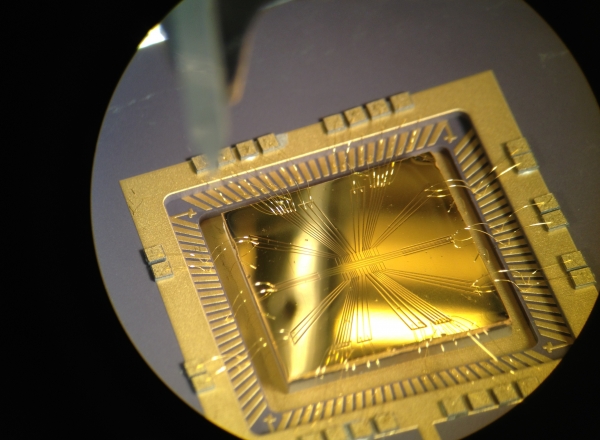NQIT Graduate Student wins top science photography prize for image of gold chip ion-trap
We're very excited to announce that one of our gradaute students, Diana Prado Lopes Aude Craik, who is studying in Professor David Lucas' lab, has won the overall prize in a national science photography competition, organised by our funding body, the EPSRC (the Engineering and Physical Sciences Research Council).
‘Microwave ion-trap chip for quantum computation’, by Diana Prado Lopes Aude Craik and Norbert Linke, from the University of Oxford, shows the chip’s gold wire-bonds connected to electrodes which transmit electric fields to trap single atomic ions a mere 100 microns above the device’s surface.
The image, taken through a microscope in one of our cleanrooms in the Physics Department in Oxford, came first in the Eureka category as well as winning overall against many other stunning pictures, featuring research in action, in the EPSRC competition – now in its third year.
Diana Prado Lopes Aude Craik, explained how the chip works: “When electric potentials are applied to the chip’s gold electrodes, single atomic ions can be trapped. These ions are used as quantum bits (‘qubits’), units which store and process information in a quantum computer. Two energy states of the ions act as the ‘0’ and ‘1’ states of these qubits. Slotted electrodes on the chip deliver microwave radiation to the ions, allowing us to manipulate the stored quantum information by exciting transitions between the ‘0’ and ‘1’ energy states.
“This device was micro-fabricated using photolithography, a technique similar to photographic film development. Gold wire-bonds connect the electrodes to pads around the device through which signals can be applied. You can see the wire-bonding needle in the top-left corner of the image. The Oxford team recently achieved the world’s highest-performing qubits and quantum logic operations.”
The ion trap forms the core part of NQIT's hardware approach to building a quantum computer.
The development of the ion-trap chip was funded jointly by the EPSRC and the US Army Research Office.
Other winning photographs in the competition were of a spectacular 9.5 metre wave created to wow crowds at the FloWave Ocean Energy Research Facility at the University of Edinburgh, an iCub humanoid robot learning about how to play from a baby as part of robotics research taking place at Aberystwyth University, an intense, blinding light of plasma formed by an ultrafast laser being used to process glass at the EPSRC Centre for Innovative Manufacturing in Ultra Precision at the University of Cambridge and a beautiful rotating jet of viscoelastic liquid water resembling a spinning dancer that demonstrates the effect of adding a tiny amount of polymer to water and an example of fluid dynamics research at Imperial College London.
Read more about the EPSRC Science Photography Competition and the other winners here.
